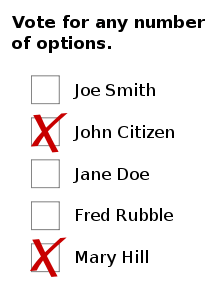
Instant runoff revisited: progressive voters know Green Party represents alternative to Democrats | Democracy, elections, and voting at Democracy Chronicles
Getting a better voting system enacted, for national office, will be very difficult—and maybe impossible. The problem is that of course the existing legislators, and their bribers, aren’t motivated to replace the voting system that keeps them in power. If there is a voting system that can be enacted at national level, it would be Approval. But any voting system reform might be impossible, without first electing a new President and Congress. The Green Party U.S. (GPUS) is by far the most win-able party that offers genuine progressive reform and improvement. Their platform includes voting-system reform. Their platform offers to replace Plurality with Instant Runoff (IRV).
Of course some of us have discussed IRV’s problems. Its worst ones include FBC failure, and count-fraud–vulnerability, due to not being precinct-summable. But because, most likely, the only way that we’re ever going to get a better voting system for national office will be by electing a better Congress and President, and because the Greens are the most win-able progressive party, and because IRV is the new voting system that the Greens offer to enact, then I suggest that IRV deserves another look. Let’s look at its two significant problems: FBC failure, and count-fraud–vulnerability due to not being precinct-summable.
FBC Failure:
I’ve been rejecting every voting system that fails FBC. But, because of what I said a few paragraphs back, let’s take a closer look at IRV’s FBC failure. Any electorate that can elect the Greens in a Plurality election isn’t going to have any trouble using IRV. Such an electorate must have already become able to not be unduly influenced by Plurality’s FBC failure. An electorate that can elect the Greens in a Plurality election is competent enough to get by without FBC. The U/a strategy for IRV is to rank the acceptable candidates in order of (some measure of, or feel for) win-ability. As for the unacceptables, it doesn’t really matter how you rank them, because, your vote won’t reach them unless the acceptables have all been eliminated.
I don’t know how to rank the unacceptables in a non-0-info u/a election, but it doesn’t matter. In a 0-info election, rank all the candidates in sincere order of preference. Approval and IRV are the methods that meet the 0-Info Sincerity Criterion.
IRV’s lack of precinct-sum-ability and resulting count-fraud–vulnerability
For one thing, we could expect that, in a Green government, there wouldn’t be official count-fraud. Of course there could still be individuals motivated to perpetrate count-fraud. But a national IRV hand-count could be done in a way that wouldn’t be seriously or particularly count-fraud–vulnerable because each precinct, around the country, does a hand-count of the candidates’ top-counts, and sends them in to the national count headquarters, via some secure sending method.
Each precinct’s hand-count, and the national hand-count, would be conducted and observed by representatives of a variety of parties all across the political spectrum. Each participating party would also televise and video-record the count at the precincts and in the national hand-count, with its own video camera and sound-recorder. Likewise, each participating party would have its own video camera and maybe its own lock, protecting the stored ballots and count records. The national count headquarters hand-counts those top-totals, to determine who is eliminated.
The information about the eliminated candidate is sent to the local precincts, and is also announced in the ongoing report-broadcast. Each precinct crosses that eliminated candidate’s name out from the rankings, and again does a hand-count of the candidates’ top-counts, and sends them to national headquarters. The precincts would keep their ballots securely. The paper ballots would ideally be printed out from voting machines. The voter would look at his/her printed-out ballot, to ensure that it’s as s/he wants it. The national count headquarters would record each precinct top-count that it receives, from each precinct, at each stage. That would be recorded on paper, and securely guarded.
The national count headquarters would announce the candidates’ total top-counts, in the ongoing report-broadcast, at each stage of the count. People in the local precincts could examine the records of the top-counts nationally-recorded from their precinct. There’s probably a way that the above count method could be done securely. I much prefer Approval’s maximally simple hand-count. I prefer Approval’s compliance with FBC, and the various consistency criteria; but IRV would do just fine for an electorate competent enough to elect the Greens with Plurality.
Instant Runoff Revisited: Regarding IRV’s properties
Aside from IRV’s FBC failure, its lack of precinct sum-ability, and its count that’s more complicated than Approval count problems (that have already been dealt with in this message) IRV’s has some very good properties. IRV is one of the very few methods that meets Later-No-Harm. For one thing, that means no chicken dilemma. IRV meets Mutual-Majority and Clone-Independence, and Later-No-Help. So, IRV meets these desirable criteria:
- Later-No-Harm (LNHa)
- Later-No-Help (LNhe)
- CD
- Mutual Majority
- Clone-Independence
The definitions of these criteria can be found at Electowiki so feel free to take a look at the links at the end of this article. CD is a precisely-worded criterion that measures for freedom from the chicken-dilemma. It will be defined in a subsequent article. Mutual-Majority says that a sincere-voting majority should be able to elect a candidate from a candidate-set that it prefers to all the other candidates. Later-No-Help (already defined in a recent article) says that you shouldn’t need to vote for additional candidates, to help the candidates whom you’re already voting for. Later-No-Harm says that voting for additional candidates (provided that you don’t vote them above the candidates you’re already voting for and, if the balloting allows it, you vote, over them, the candidates you’re already voting for) shouldn’t harm the chances of the candidates you’re already voting for.

Clone-Independence is about the winner not being changed by the addition of a candidate who is so similar to another candidate or candidate-set, that everyone votes him/her adjacent to that candidate or candidate-set. Yes, I’d much rather have Approval or Score, and that’s what I recommend for enactment proposals. I just don’t offer much hope for the enactment of any reform voting system without first electing a new Congress and President by Plurality. The Greens are the win-able progressive party. IRV is the voting system that they offer.
If we can elect the Greens with Plurality, then IRV will be just fine for us. Of course, one other possibility would remain, when the Greens are in office: Advocate Approval and Score to them. But I’ve explained above why, if IRV is the voting system implemented by the Green government, then IRV will be just fine. I’ve told why failure of Clone-Independence isn’t a problem for Approval, Score, ICT, and Symmetrical ICT, but Clone Independence is still a nice bonus with IRV. I’ve told why Mutual Majority doesn’t mean much, without FBC. But that doesn’t apply to an electorate that is competent enough to elect the Greens with Plurality.
Making the Best Use of Plurality and Easily Voting Optimally in Plurality
I’ve mentioned this in a previous article, but I should say it here too: plurality’s u/a strategy is to combine votes on the most win-able acceptable candidate. I suggest that, for progressives, it’s very obvious that the nominee of the Green Party U.S. (GPUS) is, by far, the most win-able acceptable candidate. That makes it very easy to implement Plurality’s optimal u/a strategy. Progressives should vote for the nominee of the Green Party U.S. in presidential and Congressional elections and why not in state elections too.
It’s important that anyone who votes finds out about what’s offered. Don’t let the TV (or the radio either) be your information-source. Look at the platforms of some of the media-banned parties (that’s all of the parties other than the officially endorsed and media-allowed Republocrat party—usually spoken of as if it were two parties, Democrat and Republican). I claim that the GPUS platform offers the very things that people around the county are saying that they want, and remedies the things that people around the country are complaining about.
- https://wiki.electorama.com/wiki/Later-no-harm
- https://wiki.electorama.com/wiki/Later-No-Help
- https://wiki.electorama.com/wiki/Chicken_Dilemma_Criterion
- https://wiki.electorama.com/wiki/Mutual_majority_criterion
Leave a Reply